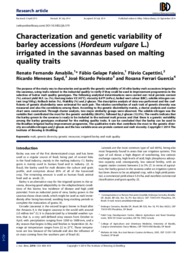Characterization and genetic variability of barley accessions (Hordeum vulgare L.) irrigated in the savannas based on malting quality traits.
Characterization and genetic variability of barley accessions (Hordeum vulgare L.) irrigated in the savannas based on malting quality traits.
Author(s): AMABILE, R. F.; FALEIRO, F. G.; CAPETTINI, F.; SAYD, R. M.; PEIXOTO, J. R.; GUERCIA, R. F.
Summary: Abstract: The purpose of the study was to characterize and quantify the genetic variability of 30 elite barley malt accessions irrigated in the savannas, using traits related to the industrial quality to verify if they could be used in improvement programmes in the selection of better malt quality genotypes. The following analytical determinations were carried out: total protein content (%), extract yield M.F. i.a. (%), Hartong index VZ (45°C), viscosity 8.6°P (mPa s), boiled wort colour (EBC), soluble nitrogen content (mg/100 g), Kolbach index (%), friability (%) and β-glucan. The descriptive analysis of data was performed and the coefficients of genetic dissimilarity were estimated for each pair. The relative contribution of each trait of genetic diversity was measured and also the correlations among them. According to the genetic dissimilarity matrix, a cluster analysis and scatter chart were constructed. Through cluster analysis, two major similarity groups were observed. The soluble nitrogen was the variable that contributed the most for the genetic variability (86.6%), followed by β-glucan (12.5%). The results indicate that the barley grown in the savanna is ready to be included in the national malt process and that there is a genetic variability among the barley genotypes evaluated for the malting quality traits. It can be concluded that the barley can be used in the Brazilian irrigated barley improvement programme. The qualitative traits that contribute the most to the genetic diversity are soluble nitrogen and β-glucan and the less variable ones are protein content and malt viscosity.
Publication year: 2014
Types of publication: Journal article
Unit: Embrapa Cerrados
Observation
Some of Embrapa's publications are published as ePub files. To read them, use or download one of the following free software options to your computer or mobile device. Android: Google Play Books; IOS: iBooks; Windows and Linux: Calibre.
Access other publications
Access the Agricultural Research Database (BDPA) to consult Embrapa's full library collection and records.
Visit Embrapa Bookstore to purchase books and other publications sold by Embrapa.

